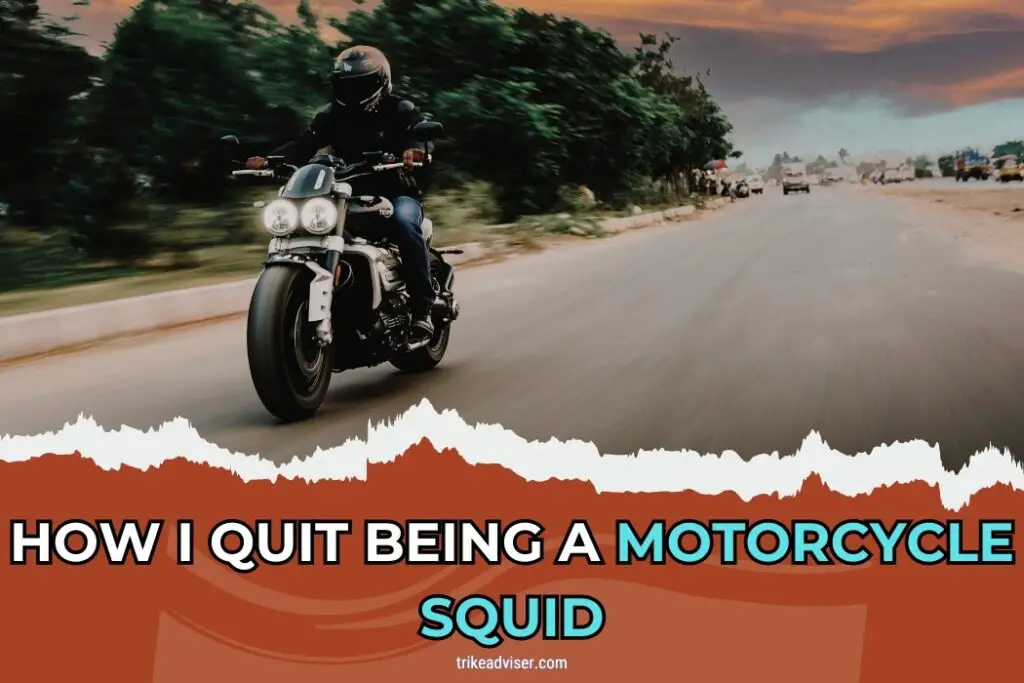Ever felt the thrill of speeding on a motorcycle, yet knew it was reckless? I did. Many riders enjoy the sheer adrenaline of riding fast and hard.
But this often tags them as SQUIDs: Stupidly Quick, Underdressed, Imminently Dead. Sounds harsh, right? The thrill, the speed—it’s addicting.
Yet, it’s fraught with risks. I was no different, weaving through traffic, skimping on gear. The reality hit hard after witnessing a nasty spill. Was that reckless freedom worth my life? Deciding to change was tough but essential.
In this shift, I discovered not just safer riding practices but greater enjoyment in riding itself. Join me as I share how simple this transition can be. No heroics, just smart, sustainable riding.
How to Quit Being a Motorcycle SQUID – Let’s Start!
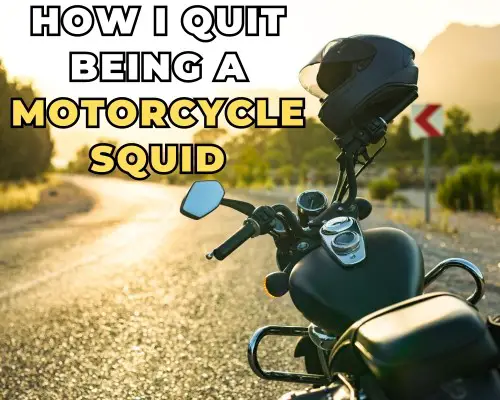
Understand the Risks
Every time I threw my leg over my bike, I thought that. However, motorcycling is a trick. There are always and are risks.
It disturbed me to hear that motorcycle riders have a 29-fold higher risk of dying in a collision than passengers in cars. Just one fact caused me to reevaluate my carefree riding style.
Now, I see every ride as a calculated risk, one that demands respect and preparation. Recognizing the danger isn’t pessimism—it’s the first step to riding smarter and living longer.
Get Proper Training
I once believed that handling a bike came naturally. I was wrong. After a few close calls, I enrolled in a motorcycle safety course. It was eye-opening.
Statistics from the Motorcycle Safety Foundation show that proper training can reduce accident risks by up to 67%. The courses taught me not just techniques but also the philosophy of safe riding.
They equipped me to handle my bike in ways I hadn’t thought possible, turning potential disasters into manageable situations.
Wear the Right Gear
I used to think gear was optional until the day I skidded on loose gravel. Only the gear saved my skin—literally.
Research indicates that proper motorcycle attire reduces the risk of open wound injuries by more than 50%. Today, I suit up fully for every ride.
Helmet, jacket, gloves, boots—it’s my armor. And honestly, feeling that protected adds to my confidence on the road.
Ride Defensively
It wasn’t until a car cut me off during a routine ride that I fully grasped the importance of defensive riding. Now, I ride as if invisible to other drivers, because often, to them, I am.
Defensive riding has reduced my close calls dramatically. It’s about expecting the unexpected, maintaining a buffer zone, and always having an escape plan. This proactive approach isn’t about fear; it’s about control.
Continue Learning
Motorcycling, like life, is a continuous learning curve. Every ride, every mile adds to my experience. I stay updated with the latest in bike technology and safety through forums and publications.
Upgrading my skills has become a routine, just as essential as servicing my bike. This commitment to learning keeps my rides both exciting and safe.
Respect the Bike
Early on, I underestimated my bike’s power. A harsh lesson on a wet day taught me respect. Now, I understand my bike’s limits and ensure it’s well-maintained.
A reliable bike is a safer bike. Regular checks and timely repairs keep it in top condition, ready for whatever the road throws our way.
Ride Sober
Riding under the influence was never an option for me, yet I’ve seen its impact on others. Alcohol-related crashes are tragically common and entirely avoidable.
Sobriety on the road isn’t just about following laws—it’s about safeguarding lives. Mine and others.
Follow Traffic Laws
In my early days, I saw traffic rules as hurdles to my enjoyment. Not anymore. Observing speed limits and signals has nothing to do with courage; it’s about wisdom.
Adhering to these laws protects everyone on the road, including me.
Ride Within Your Abilities
Trying to impress with risky maneuvers was once my style. No longer. I’ve learned to gauge my skills realistically and push boundaries cautiously.
It’s not about limiting thrill; it’s about ensuring tomorrow’s ride.
Be Patient
Patience was never my strong suit, especially on the road. But mastering riding skills doesn’t happen overnight. It’s a gradual, rewarding process.
Patience has not only made me a better rider but a more complete person.
The Realities of Motorcycle Safety
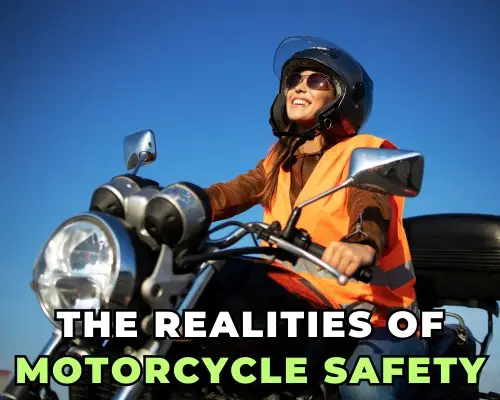
Understanding the risks and dispelling myths about motorcycling is essential for every rider. Here’s a deeper look:
Understanding the Statistical Dangers of Reckless Riding
That’s what I believed until I found out that, in comparison to cars, motorcyclists had a 27-fold higher risk of being involved in a fatal accident every mile driven.
I was enlightened early in my riding career by this startling figure from the National Highway Traffic Safety Administration.
These harsh facts are frequently overshadowed by the charm of the open road, but awareness of them is the first step toward safety.
Reckless behaviors like speeding or darting through traffic contribute significantly to these figures. Reflecting on a close call I had, where a sudden swerve could have been fatal, underscores a critical lesson: safety isn’t just about following rules—it’s about making smart choices consistently.
Key Points to Reflect On:
- Accident Statistics: Remember, motorcyclists face a much higher risk of severe injury or death.
- Reckless Riding: Common behaviors like speeding dramatically increase your risk.
- Safety First: Learning defensive riding techniques isn’t just useful, it’s potentially lifesaving.
Debunking Myths About Motorcycling Invincibility
The myth of the “invincible rider” can be compelling. I used to think my quick reflexes and sharp eyes could keep me out of any trouble.
However, motorcycles inherently offer less protection than cars. They lack the protective barrier of a car body, and airbags, and are more susceptible to road conditions.
It’s a hard truth I faced during a minor crash that left more than just physical scars—it shattered my illusion of invincibility.
Here’s the truth: no matter how skilled, every rider is vulnerable. Approximately 25% of motorcyclists involved in fatal accidents were found to be riding safely at the time, which challenges the notion that only reckless riding leads to trouble.
Myths to Challenge:
- Sense of Invulnerability: Skill and confidence should not be mistaken for invincibility.
- Misjudged Protection: The lack of physical barriers on a motorcycle means less protection, not more freedom from harm.
- Overconfidence in Skills: Relying too heavily on your riding skills can lead to risky behaviors.
Embracing a Culture of Safety
Adopting a mindset of continuous education and respect for the riding process can profoundly change your approach to motorcycling.
Each ride is an opportunity to practice and reinforce safe behaviors. For instance, joining a community or group that emphasizes safe riding can reinforce good habits and provide support for sticking to them.
Maintenance and Respect for Your Motorcycle
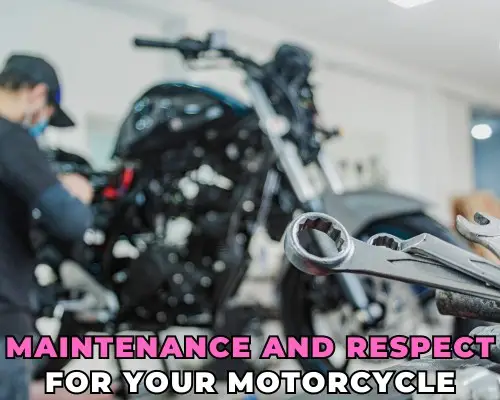
Proper motorcycle maintenance goes beyond mere checklists; it’s about fostering a bond that enhances both performance and safety. Here’s an expert take on doing it right.
Regular Maintenance Schedule and Checklist
“Sounds easy, right?” That’s what I thought until I skipped an oil change cycle, leading to a sluggish ride and eventually, a costly repair. Regular maintenance is not just a suggestion; it’s crucial.
Essential Maintenance Tasks:
Engine Oil Changes: Just as you must make sure your bike has engine oil, you also need to change your engine regularly to maintain its health and longevity. Not only is this a sensible choice, but it’s essential.
Spark Plug Replacement: Changing your spark plugs every 7,500 miles ensures a smooth, efficient burn, which is crucial for peak performance, even if it may not seem like much.
Tire Pressure Checks: I check mine weekly, and it’s a game changer. Correct pressure extends tire life and keeps handling sharp, crucial for those sudden swerves.
Chain Lubrication: Whether it’s a dusty trail or a muddy path, a lubricated chain ensures a smooth ride. I learned the hard way when a seized chain threw me off on a curve.
Brake Pad Inspection: Every few months, I run a check. Because when I need to stop, I need to know I can.
Air Filter Cleaning or Replacement: A clean filter means an engine that breathes easier, and runs better. At 6,000 miles, it’s a simple step for maintaining engine health.
Brake System Inspection: Twice a year, because brakes are your best friend when a truck pulls out unexpectedly.
Coolant Change: Overheating isn’t an option, especially on a hot day mid-ride. Changing coolant every two years has saved my engine more than once.
How Proper Bike Care Enhances Safety
I once met an old-timer who told me, “Take care of your bike, and it’ll take care of you.” True story. Every maintenance step directly impacts safety.
Safety Enhancements Through Maintenance:
Predictable Performance: Just last year, during a tight bend on a wet road, my well-maintained brakes and tires saved me from skidding off. There’s no substitute for reliability.
Decreased Breakdowns: Have you ever had a breakdown that left you stuck? It’s risky in addition to being inconvenient. You’re less likely to find yourself in a precarious situation if you do regular checks.
Enhanced Handling: Your bike’s responsiveness is just as important to handling as skill.
Properly maintained, it’ll handle like a dream, respond like it should, even in adverse conditions.
Implementing a Maintenance Routine
Start with your bike’s manual—yes, that book you stowed away. It’s your bible. Set reminders, keep a log, and maybe most importantly, get your hands dirty.
The more you understand your bike, the more attuned you are to its needs. And there’s a certain pride in that, a connection. It’s not just maintenance; it’s respect.
Adjust your Motorcycle for Long Rides
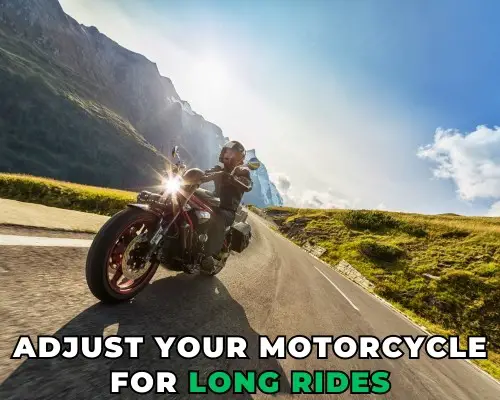
Determine Your Destination
Sounds easy, right? Think again. Mapping out your journey isn’t just about picking points on a map. It’s about understanding terrain, weather patterns, and traffic flow.
Use multiple navigation tools for backup. Like the time I found a hidden mountain pass through local apps—it saved me hours!
Build Riding Stamina
Gradual Increase in Riding Time
Just like training for a marathon, extend your saddle time weekly. Start with an hour, then ramp it up. This method helped a friend increase his tolerance so much, he rode cross-country without a hitch. Regular rides also help you bond with your bike, turning it into a trusty partner.
Check Your Tires
Ensure Good Condition
A true story: A pal thought his old tires would make it one last trip. Halfway through, a blowout in the desert! Always check for tread wear and air pressure. Upgrading to premium tires might seem pricey but think of it as cheap insurance.
Adjust Your Bike to Fit You
Handlebars and Footpegs
Remember my first long ride? An hour in, and my back screamed. I learned that adjusting the handlebars and footrests can prevent such pain.
Consider ergonomic enhancements like padded grips or adjustable levers. These tweaks are vital for long-term comfort and control.
Take Breaks Often
Stretch, Rest, and Rehydrate
During a ride across Nevada, I learned the hard way that frequent breaks are a must. Without them, fatigue creeps in, and reaction times slow—dangerous in any condition. Plan stops at interesting locales, maybe a historic site or a quirky diner, to make breaks more enjoyable.
Wear Comfortable Gear
Invest in Comfort
Ever ridden with a bad seat? I did, once. Never again. Invest in a custom seat—it’s like the difference between hardwood and memory foam.
Also, consider specially designed riding apparel with padding in critical areas to protect against wind and road vibrations.
Stay Hydrated
Drink Plenty of Water
On a particularly scorching ride through Arizona, I nearly faced dehydration. Now, I use a hydration pack accessible without stopping.
Hydration affects concentration—critical when you’re navigating through rush-hour traffic on unfamiliar roads.
Eat Light Meals
Consume During Off-Peak Hours
Eating heavily before a ride? Bad idea. It leads to lethargy. Opt for high-protein, low-carb meals to keep energy levels stable. Packing snacks like almonds or jerky can save time and keep you fueled without the need for long stops.
Maintain Your Bike
Adjustments for Height and Weight
Just last year, I tweaked my bike’s suspension to better handle my gear’s weight—it transformed my ride from shaky to smooth.
If your bike isn’t already equipped, consider aftermarket adjustments. Properly tuning your suspension can significantly improve handling and comfort over long distances.
As an Amazon Associate, I earn from qualifying purchases, at no additional cost to you. Read Our Affiliate Disclosure.

